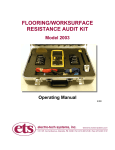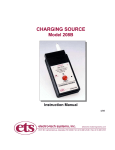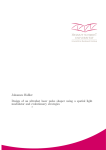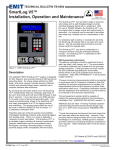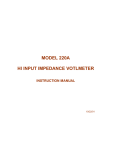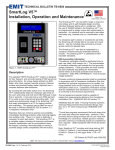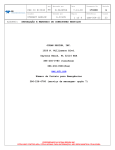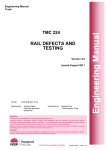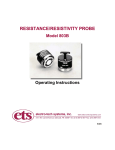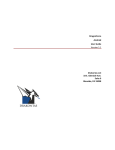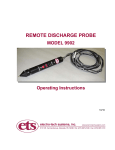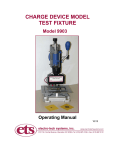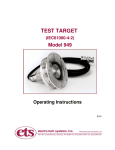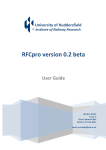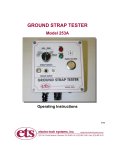Download 846 User Manual - Electro Tech Systems
Transcript
MODEL 846 ELECTRODES FOR TESTING CONCRETE PANEL FLANGEWAY FILLER AND OTHER RESISTANCE MEASURING APPLICATIONS Operating Instructions 1.0 GENERAL DESCRIPTION The Model 846 Clamp Electrodes shown in Figure 1.0-1 is designed to test concrete panel flangeway filler blocks in accordance with Union Pacific Railroad Specification 121505. The probes feature a unique dual-pad design for measuring both point-to-point resistance and volume resistance/resistivity. Figure 1.0-1 Model 846 Clamp Electrodes The electrodes are used with resistance indicators and meters having a test voltage of 500 volts (AEMC Models 1035, 1045 and 1060) The following specifications are for the Model 1035. 1 1.1 Model 1035 Megohmmeter Resistance Ranges: <1 to 400 kOhms, +3% of reading, ±1 ct @ VE=7-9V 10k to 2.0 Gigohm, +3% of reading, ±5 ct (<40 Megohm), ±2 ct (>40 Megohm) @ VE=50V 20k to 2.0 Gigohms, @ VE=100V 50k 20 Gigohm @ VE=250V 100k to 20Gigohm @ VE=500V Short circuit current: ≤3ma Voltage Ranges: 0 to 600 Volts AC or DC Audible Tone: Upper/lower alarm thresholds, switchable ON/OFF Batteries: Six (6)x1.5 Volt AA alkaline Battery Life: 3500 tests @ 5 seconds each 2.0 ELECTRODE DESCRIPTION The Model 846 Clamp Electrodes shown in Figure 1.0-1 consists of 0.375 diameter (9mm) conductive elastomer pads with volume resistivity of 0.01 ohm-cm and Shore-A hardness of 65 durometer. The pads are mounted to stainless steel electrodes installed onto an insulated clamp having a resistance >1012 Ohms exerting approximately 20 pounds (9kg) of force. The smaller electrode can be inserted up to 1.5” (38mm) into a formed block. When measuring surface resistance one pad from each clamp is used. When measuring volume resistance both pads from a single clamp are used. Standard .162” banana jacks are located on the sides of each handle. Standard cables with banana plugs supplied with the resistance meters are satisfactory for making the resistance measurements. 3.0 USING THE ELECTRODES 3.1 Characteristics of Insulation Material When testing insulation material the current flowing through the material has three components: Capacitance Charging Current, which starts out at a high level and drops after the insulation has been charged to full voltage. Absorption Current, also an initially high level but then drops and is based on the absorption effect of good insulation compared to that of moist or contaminated insulation. Finally, Leakage (Conduction) Current, is a small steady current that flow both through and over the insulation. 2 With good insulation, the conductance or leakage current should build up to a steady value that is constant for the applied voltage. Since readings are time dependent (electrification time), the reading is apparent resistance. The conductivity of the rubber will also change with applied pressure. Therefore, insulation testing of rubber used for filler between concrete crossing panels and rails must also be tested with the rubber under pressure. 3.2 Characteristics of Static Dissipative and Conductive Material Thermoformed plastics that are rendered static dissipative or conductive consist of a plastic resin filler with very high resistance properties loaded with a small percentage of a conductive material such as stainless steel fibers, or carbon powder or fibers. These materials have bulk resistance properties verses the surface only resistance properties found in other ESD materials. When a voltage is applied either across or through the material the dielectric of the filler breaks down and current flows from particle to particle. As the loading of the conductive medium decreases there is greater distance between particles that requires a higher voltage to break down the increased dielectric. At some point, once a higher voltage is applied to establish continuity the resistance of the path created may become altered permanently. Loaded thermoplastic materials are effective in reducing the upper resistance limit to approximately 108 Ohms. Another characteristic associated with loaded thermoplastic materials that affects measuring it’s resistance is the microscopic insulative layer that develops on the surface of the molded part. The dielectric of this layer must be broken down before a resistance measurement can be made. Once this occurs the actual resistance of the part may be lower than the measuring range of the instrumentation used. In essence, these materials are non-linear and voltage dependent. Hence, different test voltages will give different results. Even the series resistor incorporated in virtually all resistance meters are different from meter to meter may cause variations in the measurements. Loaded thermoelectric material is generally not adversely affected by humidity, as long as it is reasonable such as less than 75%. Currently ESD materials are classified as follows: Surface Volume Conductive Dissipative Insulative <104 104 to <1011 same ≥1011 Ohms 3 Materials with bulk resistance characteristics can also be classified by specifying its volume resistivity. This is simply done by multiplying the measured resistance by the area of the measuring electrode or material surface, whichever is smaller, and divided by the thickness. ρv = A/t Rm Ω-cm All values are in cm giving a volume resistivity in Ohms-cm. The area of the measuring electrodes is 0.64 cm2. To convert to Ohms-meter, multiply by 100. Increasing or decreasing the thickness of the material will also change the actual resistance of the part with a specified volume resistivity. This is a common technique used in ESD products to achieve a particular resistance. It is the actual resistance of the part, not its resistivity that determines how a part dissipates a static charge. 3.3 Hook Up The Model 846 Clamp Electrodes can be used either in pairs using just one of the electrodes to measure the resistance across the surface of a material or alone using both electrodes to measure volume resistance. The Model 846 Clamps accept standard 0.060” banana plugs. Meters such as the AEMC Model 1035 utilize standard banana plugs with protective plastic cover. Adapters are provided to convert these covered plugs to standard plugs. Figures 3.0-1 & 2 show each type of hook up using an AEMC Model 1035 Megohmmeter. Figure 3.0-1 Surface Resistance 4 Figure 3.0-2 Volume Resistance 3.4 Test Procedure 1. 2. 3. 4. 5. 6. 7. 8. 9. 10. 11. 12. 13. 14. 15. 16. 17. 18. 19. 20. 21. 22. 23. 24. Verify megohmmeter operation by performing calibration and operation checks per manufacturer recommendations. Verify test set by measuring a 10 Megohm 1% resistor. Read and record the ambient temperature, percent relative humidity and dew point. Read and record the surface temperature of the test specimen. Verify that surfaces of clamps and test specimen are clean and dry. Do not use a cleaner that could leave a non-conductive residue. Place one clamp on test specimen. Read and record Date and Pressure Start Time (PST) the clamp was placed on specimen and pressure was applied. Allow pressure on test specimen to stabilize – wait at least 5 minutes before applying voltage to test specimen. Connect clamp leads to megohmmeter. Insulation resistance measurements will be in error if residual charges exist on the insulation. A residual charge will show as a reverse deflection of the insulation resistance meter after connections are made, but before voltage is applied. Therefore, prior to measuring the insulation resistance, the test specimen must be completely discharged. An air ionizer will effectively discharge any residual charge on an insulator. Select a DC voltage of 500 volts to be applied as the standard test voltage. Read and record the Test Voltage. Read and record the Electrification Start Time (EST) – the time the megohmmeter was turned on. Start Test – turn megohmmeter Test Voltage ON. Read and record the Insulation Resistance (IR) at 30 seconds. Read and record the Insulation Resistance (IR) at 1 minute. Read and record the Insulation Resistance (IR) at 10 minutes. Stop test – turn megohmmeter Test Voltage OFF. Read and record the Total Time (TT) that the sample was under pressure in the test fixture. Disconnect clamp leads from megohmmeter. Calculate and record the Dielectric Absorption Ratio (DAR) 60/30sec ratio. Calculate and record the Polarization Index (PI) 10/1min ratio. The minimum Insulation Resistance (IR) after 10 minutes must be greater than 10 Meg ohms. Repeat for every 5th batch, (1 batch is approximately 400 to 600 pounds) or as needed. 5 To measure volume resistance, clamp a single electrode assembly to the part to be measured. Follow the measurement procedure above. To calculate the volume resistivity, multiply the measured resistance by the area of the electrode (64cm2) divided by the thickness of the material in cm (refer to Section 3.1). 4.0 CALIBRATION The Model 846 Clamp Electrodes incorporate a force adjustment screw that allows the user to vary the clamping force from 1 to 50 lbs. Figure 4.0-1 shows the location of the adjusting screw. Turning the screw clockwise increases the force. The force is preset at the factory to 20 lbs. One method for establishing the desired force is to place an equivalent weight onto one handle while the other handle rests on a rigid surface. Adjust the screw until the jaws just start to open. Figure 4.0-1 Force adjustment 6/07 6 5.0 WARRANTY Electro-Tech Systems, Inc. warrants its equipment, accessories and parts of its manufacture to be and remain free from defects in material and workmanship for a period of one (1) year from date of invoice and will, at the discretion of Seller, either replace or repair without charge, F.O.B. Glenside, similar equipment or a similar part to replace any equipment or part of its manufacture which, within the above stated time, is proved to have been defective at the time it was sold. All equipment claimed defective must be returned properly identified to the Seller (or presented to one of its agents for inspection). This warranty only applies to equipment operated in accordance with Seller's operating instructions. Seller's warranty with respect to those parts of the equipment which are purchased from other manufacturers shall be subject only to that manufacturer's warranty. The Seller's liability hereunder is expressly limited to repairing or replacing any parts of the equipment manufactured by the manufacturer and found to have been defective. The Seller shall not be liable for damage resulting or claimed to result from any cause whatsoever. This warranty becomes null and void should the equipment, or any part thereof, be abused or modified by the customer of if used in any application other than that for which it was intended. This warranty to replace or repair is the only warranty, either expressed or implied or provided by law, and is in lieu of all other warranties and the Seller denies any other promise, guarantee, or warranty with respect to the equipment or accessories and, in particular, as to its or their suitability for the purposes of the buyer or its or their performance, either quantitatively or qualitatively or as to the products which it may produce and the buyer is expected to expressly waive rights to any warranty other than that stated herein. ETS must be notified before any equipment is returned for repair. ETS will issue an RMA (Return Material Authorization) number for return of equipment. Equipment should be shipped prepaid and insured in the original packaging. If the original packaging is not available, the equipment must be packed in a sufficiently large box (or boxes if applicable) of double wall construction with substantial packing around all sides. The RMA number, description of the problem along with the contact name and telephone number must be included in formal paperwork and enclosed with the instrument. Round trip freight and related charges are the owner’s responsibility. 7







